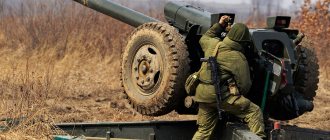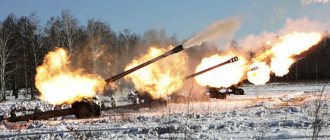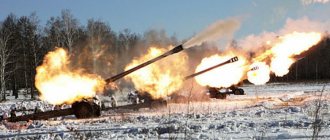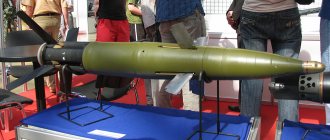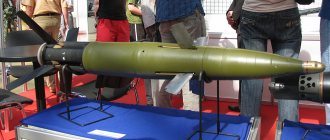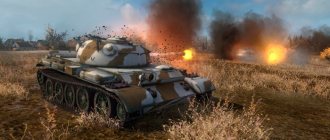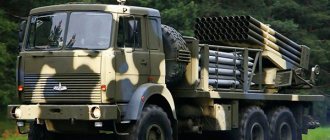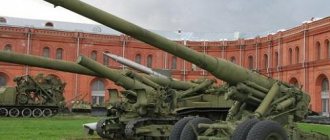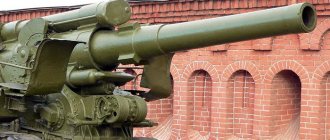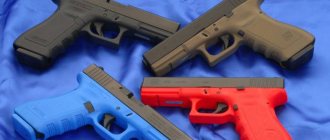The 152 mm D-20 howitzer gun is another example of the old Soviet tradition of combining components of existing artillery systems to create new ones. In this case, a new 152 mm barrel was installed on the carriage of a 122 mm D-74 field gun. This 152 mm howitzer gun was developed immediately after the end of the Great Patriotic War (1941-1945), but industrial production of the D-20 began only in the early 50s, and the gun was first shown in 1955.
Howitzer-gun D-20 - shooting video
Basically, the D-20 is similar to the earlier model of the 152-mm howitzer D-1, but it has a different arrangement of recoil shock absorbers, and the mass of the D-74 carriage is such that additional wheels on the front of the frame are required to move the D-20. Also different is the shape of the shield.
However, the main difference between the D-20 and the D-1 is the choice of ammunition. The D-20 can still fire most types of D-1 ammunition, but it has its own family of ammunition. The D-20 became one of the first Soviet artillery systems capable of firing tactical nuclear weapons. There was also a large selection of chemical munitions (now withdrawn from service). An improved system of variable power propelling charges made it possible to increase the maximum range of the D-20 shot to 17,410 meters, and the use of an active-missile projectile allows the range to be increased to 24,000 meters. One of the latest innovations is the use of a laser-guided anti-tank projectile, the Krasnopol, weighing 50 kg.
The 155 mm barrel mounted on the 2S5 self-propelled howitzer is a modified D-20 barrel. The former Yugoslavia offered for export a modification of the D-20 with a 39-caliber barrel, adopted by the Yugoslav army - the state of affairs is currently unknown. The Romanian army is armed with a towed howitzer of its own design, known under the designation Model M1985, in the design of which some features of the D-20 are visible. The Chinese-made modification is designated 152 mm Type 66.
Photo Msta-B
Artillery tractor "Bear" based on the KamAZ-63501 chassis towing a 152-mm howitzer 2A65 "Msta-B"
Breech 2A65 "Msta-B"
Modifications
The D-20 is in service in at least 13 countries and was produced under license in the People's Republic of China as the Type 66 (or an upgraded version of the Type 66-1). The self-propelled gun based on it, known as the Type 83, was first introduced in the mid-1980s. Yugoslavia also manufactured the M84 NORA-A gun-howitzer, developed on the basis of the D-20, and Serbia, based on the 155-mm modification of the M84 NORA-A, designed the Nora B-52 self-propelled gun on a four-axle FAP-2632 wheeled chassis.
Russia
D-20M "Khitin" (GAU Index - 52-P-546M) - a modernized version, equipped with an automatic rammer, increasing the rate of fire to 7-8 rounds/min. The modernization was carried out by the Titan Central Design Bureau. Offered for export.
China
— Type 66 (English) Russian. - Chinese version of the D-20 produced under license. The modernized version is known as Type 66-1. - Type 83 - a self-propelled artillery unit created on the basis of artillery parts from a Type 66 howitzer, its design is identical to the 2S3 Akatsiya self-propelled gun.
Romania
The A411 is a howitzer developed by Arsenal Armatei, basically similar to the D-20. This option uses its own 152-mm ammunition, which (with a barrel length of 20.5 calibers) has a maximum range of 17.2 km (24 km with the OF-550 projectile). In the Romanian army, the A411 is known as the 152-mm towed gun-howitzer M1981 (Romanian: Tun/Obuzier calibrul 152-mm tractat M1981).
Also, Romania manufactured the 130-mm A412 cannon (based on the artillery unit of the 130-mm Chinese version of the D-74 type 59-1 cannon) known under the designation M1982 (or M82) and the 152-mm A425 howitzer (based on Chinese technology) known under the designation M1985 (or M85), which used the carriage from the D-74/D-20 duplex.
Aluminum D20
| Brand: D20 | Grade: Aluminum Wrought Alloy |
| Industrial use: for the manufacture of welded products operating at room temperature or briefly at elevated temperatures | |
| Chemical composition in % of alloy D20 | ||
| Fe | up to 0.3 | |
| Si | up to 0.3 | |
| Mn | 0,4 — 0,8 | |
| Ti | 0,1 — 0,2 | |
| Al | 90,95 — 93,5 | |
| Cu | 6 — 7 | |
| Zr | up to 0.2 | |
| Mg | up to 0.05 | |
| Zn | up to 0.1 | |
| Additional information and properties |
| Material hardness: HB 10 -1 = 100 MPa |
| Mechanical properties of alloy D20 at T=20oC | |||||||
| Rental | Size | Eg. | σв (MPa) | sT (MPa) | δ5 (%) | ψ % | KCU (kJ/m2) |
| Bar | 360 | 240 | 8 | ||||
Processing of sheet metal (cladding) from alloy D20 (and similar): cladding is carried out by hot rolling a milled slab with tablets placed on it on both sides. The adhesion strength of the layers increases as a result of diffusion processes during further rolling and heat treatment.
Cladding allows you to solve the following problems: protect the surface of slabs from destruction in the first passes of hot rolling (technological cladding);
— protect the base metal from corrosion (protective plating);
- impart special physical or chemical properties to a metal. For technological cladding, AD1 grade aluminum is used. As a protective cladding, materials are selected that, under conditions of exposure to a corrosive environment, serve as an anode in relation to the base metal, which ensures its stable protection even in the presence of local damage to the cladding layer (scratches, abrasions, etc.).
For cladding sheets of alloys D1, D16, D19, D20 and AMg6, pure aluminum grade AD1 with a copper content of up to 0.02% is used; sheets of alloy B95 are clad with aluminum alloy AC with a zinc content of 0.9-1.3%.
The thickness of the cladding layer, depending on the thickness of the sheets and the purpose of the cladding, is shown in the table below.
| Cladding layer thickness | |||
| Nominal sheet thickness, mm | Thickness of the cladding layer on each side, % of the nominal sheet thickness | ||
| with normal protective cladding | with thickened protective cladding | during technological cladding | |
| Up to 1.9 | ≥ 4 | ≥ 8 | ≤ 1.5 |
| ≥ 1.9 | ≥ 4 | ≥ 8 | ≤ 1.5 |
To ensure high-quality welding of the plate and the base metal, careful preparation of the surfaces to be welded is necessary by cleaning, degreasing or etching.
Degreasing of slabs before plating is carried out either by wiping with gasoline, or by washing and mechanical cleaning in a special unit consisting of two chambers, in the first of which the slab is washed with a washing solution (soda, trisodium phosphate, etc.), in the second with hot water. Between the chambers there is a brush device for cleaning the surface from build-up.
Recently, experience in working with tablets produced directly by hot rolling has shown that their surface, without additional processing, provides fairly reliable welding to the surface of the slab.
Technological factors also have a great influence on the quality of welding. Moisture getting under the plates is unacceptable, so during the first passes rolling is done without emulsion. An incorrectly selected compression value in the first pass can lead to either non-welding of the tablets (small compressions) or to tears and the formation of folds. It is also impossible to obtain high-quality welding if you cover heated slabs with cold tablets or allow various contaminants to get between them.
The choice of rational sizes of tablets and compressions in the first two passes ensures high adhesion strength and uniformity of the cladding layer. In the first pass, the tablet receives a higher reduction than the slab, so the length of the tablet is always taken to be 10-25% less than the length of the cladding part of the slab.
Practically, by regulating the compression in the first two passes and the permissible fluctuation in the thickness of the cladding layer of sheets, the tablets are selected in such a way that tablets of the same sizes can be used for different sheet thicknesses.
The width of the tablet is equal to the width of the slab or greater by the amount of overlap when cladding the side faces.
Cladding the side faces prevents edge cracking during hot rolling and makes it possible to increase reduction during cold rolling.
Cladding of slabs in modern workshops is carried out on a production line.
Tactics and technical characteristics of the D-20 gun
— Designer: OKB-9 — Developed: 1947 — Manufacturer: , Motovilikha Plants — Options: 52-P-546, 52-P-546M, M-390
Crew (calculation): 8 people
Caliber: 152 mm
Weight of the D-20 gun
— Full combat weight, kg: 5650
Overall dimensions of the D-20 gun
— Ground clearance, mm: 380 — Length, mm: 8690 — Barrel length, mm: 5195 (34 klb) — Width, mm: 2317 — Height, mm: 1925..2520
— Shutter: Vertical semi-automatic wedge shutter — Recoil device: hydraulic buffer and hydropneumatic recuperator — Carriage: with sliding frames
— Elevation angle: −5° to 45° — Rotation angle: 58°
Rate of fire of the D-20 cannon
— 5-6 (peak) shots/min
Initial projectile speed, m/s: OFS: 511..655, BS: 600, BKS: 680
Firing range of the D-20 cannon
— Sighting range, m: 17410 — Maximum range, m: 24000 (ARS)
— Sight: PG-1M and OP-4M
— Carriage speed on the highway, km/h: up to 60
Designations
| Name | Meaning |
| Designation GOST Cyrillic | D20 |
| Designation GOST Latin | D20 |
| Translit | D20 |
| By chemical elements | D20 |
| Name | Meaning |
| Designation GOST Cyrillic | 1200 |
| Designation GOST Latin | 1200 |
| Translit | 1200 |
| By chemical elements | 1200 |
Photo of the D-20 gun
Description
Alloy D20 is used : for the manufacture of welded products, parts of turbojet engines operating at temperatures up to 300−350 ° C; welded parts and containers operating for a short time at temperatures from -253 to +300 °C; profiles with a cross-sectional area of up to 200 cm2 and a circumscribed circle diameter of up to 350 mm, intended for use in the aviation industry and special branches of mechanical engineering; pressed panels of constant cross-section with longitudinal fins for the aircraft industry, manufactured by unrolling pressed finned tubes into a plane with a web width of up to 2100 mm; pressed large-sized pipes.
Note
High-strength alloy (σв=380 MPa, σ1000150° =280 MPa).
SAU 2S3M2 Akatsiya - video
The 2S3 Akatsiya was put into service. It was supposed to be part of tank and motorized rifle divisions to destroy armored vehicles, artillery and mortar positions, as well as enemy personnel. The production of these self-propelled guns was closed only in 1993. “Akatsia” received the “Object 303” chassis, developed on the basis of the chassis of the 2K11 “Krug” air defense missile launcher and was highly praised during pilot tests. Subsequently, during operation, this tracked chassis showed good reliability.
For the manufacture of the hull and turret, sheets of rolled armor steel were used, capable of protecting against fragments of artillery shells and small-caliber mines from an armor-piercing bullet fired from a distance of 300 m.
The self-propelled guns were equipped with a B-59 diesel engine with forced fuel injection and the ability to operate in afterburner. The car has a mechanical dual-flow transmission, independent torsion bar suspension with telescopic hydraulic shock absorbers, and a gearbox made with a planetary rotation mechanism. The chassis includes six double rubber-coated road wheels on each side, four support rollers, as well as one front drive wheel and one rear guide wheel. The track width reaches 490 mm.
The Acacia body is divided into three compartments. In the bow of the hull, between the left side and the engine bulkhead, there is a control department in which the driver’s workplace is located. On the right side of the bow there is a power compartment with an engine, transmission, fuel and air supply systems, lubrication, cooling, heating and starting. The remaining part of the hull and the entire turret is occupied by the fighting compartment, the vast majority of which is located under the howitzer and ammunition rack. The commander's cupola and hatch are located in the turret roof on the left, and the loader's hatch is on the right.
The base for the Akatsiya artillery unit was a towed gun of the same purpose - the 152-mm D-20 gun-howitzer. Its internal structure, ballistics and ammunition were left unchanged. The howitzer was assigned the index GRAU-2A33. The cannon was installed in the embrasure of the tower. The gun barrel consisted of a monoblock tube, a two-chamber muzzle brake, an ejector, a clutch and a breech, a spindle-type hydraulic recoil brake with a fluid compensator, and a pneumatic knurler with an additional braking valve. The vertical pointing angle of the howitzer was made in the range from -4 to +60″. The gun had a sector-type manual lifting mechanism equipped with a push-type balancing pneumatic device. "Acacia" is capable of firing both direct fire and from closed firing positions. The ammunition includes 40 OFS OF-540 and OFS OF-25 rounds, stored in two combat racks located in the turret and hull.
At the end of the 70s. the vehicle began to be equipped with one drum-type ammunition rack, and the ammunition load increased to 46 rounds. There is a special hatch in the rear of the self-propelled gun for loading shells. In addition, the howitzer is capable of firing a wide range of projectiles: Br-540B, Br-540, illuminating parachute S1, chemical 3X3, all 152 mm. In the 1970s The Akatsiya's ammunition load was replenished with a round of 2 kt nuclear ammunition. As an auxiliary weapon, a 7.62-mm PKT machine gun is used, located above the commander's hatch and necessary to combat enemy air forces.
2S3 is equipped with a filter-ventilation unit, an automatic fire-fighting system, and a sealing system for crew workplaces, which made it possible to protect people from the effects of chemical, bacteriological and nuclear weapons. The vehicle's airtightness is maintained both during movement and during firing from ammunition stored inside the self-propelled gun. The weight of "Acacia" allows it to be transported on heavy transport aircraft.
The self-propelled gun was improved over time. There are two upgrades to this machine. The 2S3M Akatsiya appeared in 1975 and was distinguished by one drum-type ammunition rack, as well as the presence of a ZOF29 projectile with a fourfold increased fragmentation effect. In addition, the ammunition load was replenished with APS and ammunition equipped with bottom gas generators, which increased the gun’s range by 20-30%.
Standards
| Name | Code | Standards |
| Long and shaped rolled products | B52 | GOST 13616-97, GOST 13617-97, GOST 13618-97, GOST 13619-97, GOST 13620-90, GOST 13621-90, GOST 13622-91, GOST 13623-90, GOST 13624-90, GOST 13737-90, GOST 13738-91, GOST 17575-90, GOST 17576-97, GOST 29296-92, GOST 29303-92, GOST R 50066-92, GOST R 50067-92, GOST R 50077-92, OST 1 92093-83, OST 1 92041-90, OST 1 92069-77, OST 1 90113-86 |
| Sheets and strips | B53 | GOST 17232-99, OST 1 90246-77, OST 1 90166-75, TU 1-2-34-76, TU 1-804-473-2009 |
| Non-ferrous metals, including rare ones, and their alloys | B51 | OST 1 90048-90 |
| Metal forming. Forgings | B03 | OST 1 90073-85 |
| Rods | B55 | OST 1 90395-91, TU 1-9-814-81 |
| Pipes made of non-ferrous metals and alloys | B64 | OST 1 92048-90, OST 1 92048-76, TU 1-4-163-89 |
| Ribbons | B54 | OST 1-92006-79 |
| Welding and cutting of metals. Soldering, riveting | B05 | TU 1-9-210-81 |
Mechanical characteristics
| Section, mm | sТ|s0.2, MPa | σB, MPa | d5, % | d10 | Brinell hardness, MPa |
| Long products in delivery condition | |||||
| ≥240 | ≥360 | — | ≥8 | ≥100 | |
| Tape in delivery condition according to OST 1-92006-79 | |||||
| 0.8-10.5 | — | ≤235.2 | — | ≥15 | — |
| 5-10.5 | ≥254.8 | ≥362.6 | — | ≥7 | — |
| Pressed panels with fins according to OST 1 92041-90 in delivery condition | |||||
| ≥235 | ≥345 | ≥8 | — | — | |
| Plates in delivery condition according to TU 1-804-473-2009 | |||||
| 11-80 | — | ≥275 | — | ≥12 | — |
| 11-80 | — | ≥275 | — | ≥12 | — |
| Plates in accordance with GOST 17232-99 in delivery condition (transverse samples) | |||||
| 11-80 | — | ≥275 | — | ≥12 | — |
| 11-80 | ≥275 | ≥370 | — | ≥8 | — |
| Forgings up to 200 mm and stampings up to 150 mm according to OST 1 90073-85. Mode T1: Hardening + artificial aging (direction of samples is indicated) | |||||
| — | ≥365 | — | ≥4 | ≥100 | |
| ≥255 | ≥375 | — | ≥10 | ≥100 | |
| Pressed profiles of normal strength with a cross-sectional area of up to 200 cm2 and a circumscribed circle diameter of up to 350 mm (the sample is longitudinal, the thickness of the flange is indicated in the cross-section). Hardening + artificial aging | |||||
| ≥235 | ≥345 | — | ≥8 | — | |
| Pressed profiles of normal strength with a cross-sectional area of up to 200 cm2 and a circumscribed circle diameter of up to 350 mm. (longitudinal sample, the section shows the thickness of the flange). Hardening + natural aging | |||||
| — | ≤275 | — | ≥12 | — | |
| Large-sized pressed pipes according to OST 1 92048-76 in delivery condition | |||||
| ≥235 | ≥353 | — | ≥7 | — | |
